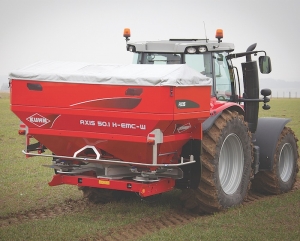First introduced on Axera hydraulic drive spreaders, the EMC system is available on Axis models arriving in New Zealand early in 2014.
EMC refers to constant measurement of mass flow (kg/min) at the point of application, independently at each disc. This allows the machine to continually adjust its aperture size to maintain a target application rate. This is achieved on hydraulic drive machines by monitoring the pressure in each of the hydraulic motors driving the discs, then correlating this pressure with the actual mass flow.
Measurements are taken and monitored every second, enabling almost instantaneous adjustment of actuator/aperture positions to either side of the machine in response to changes in fertiliser flow-ability (as may be caused by a partial blockage for example).
Similarly, because application rate is a function of forward speed, disc speed and working width, any changes to these parameters are managed by the machine’s information system to allow adjustment on the move and the maintenance of the target application rate.
The EMC system avoids the need for conventional static calibration testing, since the machine makes the adjustments automatically from simple pre-programmed data. Thus 100% of settings are done in the tractor cab.
The advantages of EMC over conventional weigh cell systems is that of providing data on and control of each side of the machine independently, and maintaining accuracy in hilly conditions.
Meanwhile for all Axis models with a GPS link, the new Opti Point system will further improve fert spreading accuracy, Kuhn says.
“Opti Point automatically controls aperture opening and closing at the headlands to minimise over- or under-application.”

















